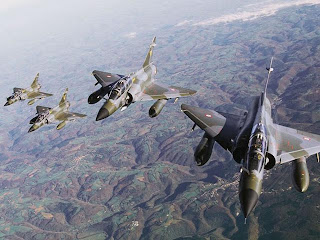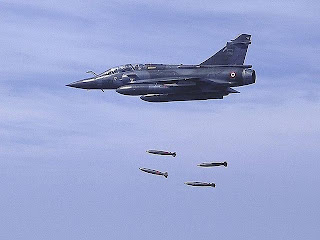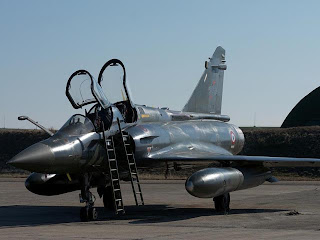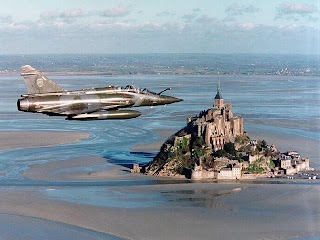The Mirage 3 is one of the greatest French fighter jets. What is remarkable about it is that its first projects dates back from 1958. Quite amazing for an aircraft of this kind. Designed by Dassault, who gained reputation after the success of the Etendard – one the first European fighter jets to reach supersonic speed, the Mirage was first born on the drawing boards of the Etendard, adapted for the navy. Put back in the drawers for a while, the Mirage benefited from the technical and operational successes from the Super Etendard.
The Mirage is quite famous in France and has been a “legend” for a long time, to be surpassed only by the recent Rafale. Built in 1960, 2000 Mirage 3 were ordered and was adopted by more than 20 countries. Its maiden flight was on November 17, 1956 et many testings were necessary to fine tune its optimal configuration. Capable of reaching twice the speed of sound – in the fifties it was quite something – the Mirage 3 was the perfect interceptor. Since the early 1960s, the Dassault manufacturing plant never stopped working full time. The Mirage was declined in various serious to suit all requirements and missions.
The latest version, the F1 is the most advanced. For the first time the engineers changed the delta wing, so characteristic of the Mirage and added even more power in the engine. The first orders were 508, especially for the French army, as well as Koweit, Greece, Irak, South Africa, and Spain. Many Mirage 3 are still in active use around the world, and a few private individuals actually own one. However, if you want to fly one of these delta, you will have to travel to Switzerland, the only place so far referenced to allow private flights in the Mirage. The fighter jet ride is extraordinary as you fly over the Swiss Alps, playing with ridges, cliffs, mountain tops, the perfect playground to do some serious evolutions.

One of the most modern fighter jets available for civilian jet fighter rides is the Mirage III. You can actually enjoy a backseat ride in this incredible jet fighter in Switzerland, making it a double whammy as you fly on a modern jet fighter, in the amazing setting of the Alps. The Mirage III is a supersonic jet fighter designed by the French Dassault aviation company during the late 1950s. It was a successful fighter aircraft, being sold to many air forces around the world and remaining in production for over a decade. Some of the world’s smaller air forces still fly Mirage IIIs or variants as front-line equipment today.
The Mirage III family grew out of French government studies begun in 1952 that led in early 1953 to a specification for a lightweight, all-weather interceptor capable of climbing to 18,000 m (59,040 ft) in six minutes and able to reach Mach 1.3 in level flight. This led to the development of prototypes with delta wings, which became the trademark of the Mirage. However a plane without tail does not fly as easily as traditional jet fighters. The lack of horizontal stabilizers meant no flaps could be used. The jet fighter also required long runways for take offs at high speed. The delta wing configuration also meant the jet plane limits its maneuverability and was unstable at low altitude. However, the delta wing design remained simple and meant the plane was fast, robust with tons of room for fuel.
The first flight of the Mirage III was on November 1956 and the fighter jet attained the speed of 1.52 Mach. With the full of its engine, the Mirage III was capable of reaching 2.2 Mach. The jet fighter was also capable of reaching 60,000ft in less than 9 seconds, which was quite good at the time. Overall 1400 Mirage III were built, many exported to Israel, Switzerland, Australia, and many countries in South America and the Middle East.
IT IS POSSIBLE TO FLY THE MIRAGE III. There is just one place in the world where one can fly the Mirage III, and this is Switzerland. It is costly, around 16,000 euros, and there are just a few days available during the year, but it is an incredible experience. Check out Fly the Mirage fighter jet for additional information on booking and price.
Check out this TV report - in French - about the first flight early 2009:

Mirage III General characteristics
Crew: 1 (trainers have 2)
Length: 15 m (49 ft 3.5 in)
Wingspan: 8.22 m (26 ft 11 in)
Height: 4.5 m (14 ft 9 in)
Wing area: 34.85 m² (375 ft²)
Empty weight: 7,050 kg (15,600 lb)
Max takeoff weight: 13,500 kg (29,700 lb)
Powerplant: 1× SNECMA Atar 09C turbojet
Performance
Maximum speed: Mach 2.2 (2,350 km/h, 1,460 mph)
Range: 2,400 km (1,300 NM, 1,500 mi)
Service ceiling: 17,000 m (56,000 ft)
Rate of climb: 83.3 m/s (16,400 ft/min)
Wing loading: 387 kg/m² (79 lb/ft²)
Read More
The Mirage is quite famous in France and has been a “legend” for a long time, to be surpassed only by the recent Rafale. Built in 1960, 2000 Mirage 3 were ordered and was adopted by more than 20 countries. Its maiden flight was on November 17, 1956 et many testings were necessary to fine tune its optimal configuration. Capable of reaching twice the speed of sound – in the fifties it was quite something – the Mirage 3 was the perfect interceptor. Since the early 1960s, the Dassault manufacturing plant never stopped working full time. The Mirage was declined in various serious to suit all requirements and missions.
The latest version, the F1 is the most advanced. For the first time the engineers changed the delta wing, so characteristic of the Mirage and added even more power in the engine. The first orders were 508, especially for the French army, as well as Koweit, Greece, Irak, South Africa, and Spain. Many Mirage 3 are still in active use around the world, and a few private individuals actually own one. However, if you want to fly one of these delta, you will have to travel to Switzerland, the only place so far referenced to allow private flights in the Mirage. The fighter jet ride is extraordinary as you fly over the Swiss Alps, playing with ridges, cliffs, mountain tops, the perfect playground to do some serious evolutions.

One of the most modern fighter jets available for civilian jet fighter rides is the Mirage III. You can actually enjoy a backseat ride in this incredible jet fighter in Switzerland, making it a double whammy as you fly on a modern jet fighter, in the amazing setting of the Alps. The Mirage III is a supersonic jet fighter designed by the French Dassault aviation company during the late 1950s. It was a successful fighter aircraft, being sold to many air forces around the world and remaining in production for over a decade. Some of the world’s smaller air forces still fly Mirage IIIs or variants as front-line equipment today.
The Mirage III family grew out of French government studies begun in 1952 that led in early 1953 to a specification for a lightweight, all-weather interceptor capable of climbing to 18,000 m (59,040 ft) in six minutes and able to reach Mach 1.3 in level flight. This led to the development of prototypes with delta wings, which became the trademark of the Mirage. However a plane without tail does not fly as easily as traditional jet fighters. The lack of horizontal stabilizers meant no flaps could be used. The jet fighter also required long runways for take offs at high speed. The delta wing configuration also meant the jet plane limits its maneuverability and was unstable at low altitude. However, the delta wing design remained simple and meant the plane was fast, robust with tons of room for fuel.
The first flight of the Mirage III was on November 1956 and the fighter jet attained the speed of 1.52 Mach. With the full of its engine, the Mirage III was capable of reaching 2.2 Mach. The jet fighter was also capable of reaching 60,000ft in less than 9 seconds, which was quite good at the time. Overall 1400 Mirage III were built, many exported to Israel, Switzerland, Australia, and many countries in South America and the Middle East.
IT IS POSSIBLE TO FLY THE MIRAGE III. There is just one place in the world where one can fly the Mirage III, and this is Switzerland. It is costly, around 16,000 euros, and there are just a few days available during the year, but it is an incredible experience. Check out Fly the Mirage fighter jet for additional information on booking and price.
Check out this TV report - in French - about the first flight early 2009:

Mirage III General characteristics
Crew: 1 (trainers have 2)
Length: 15 m (49 ft 3.5 in)
Wingspan: 8.22 m (26 ft 11 in)
Height: 4.5 m (14 ft 9 in)
Wing area: 34.85 m² (375 ft²)
Empty weight: 7,050 kg (15,600 lb)
Max takeoff weight: 13,500 kg (29,700 lb)
Powerplant: 1× SNECMA Atar 09C turbojet
Performance
Maximum speed: Mach 2.2 (2,350 km/h, 1,460 mph)
Range: 2,400 km (1,300 NM, 1,500 mi)
Service ceiling: 17,000 m (56,000 ft)
Rate of climb: 83.3 m/s (16,400 ft/min)
Wing loading: 387 kg/m² (79 lb/ft²)

















